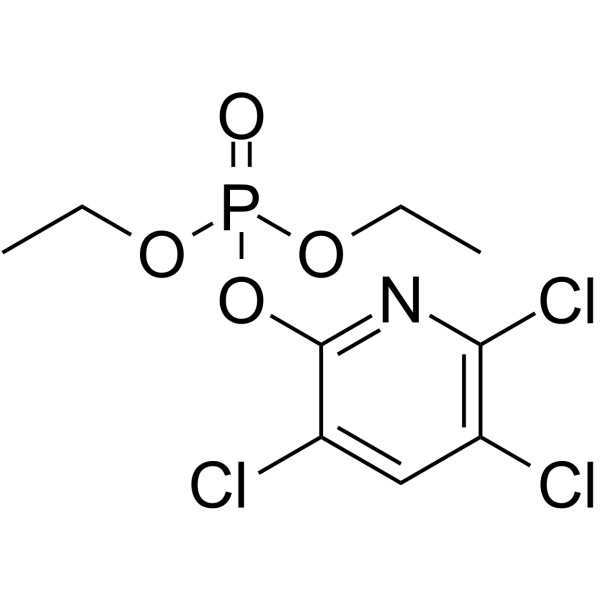Chlorpyrifos-oxon |
| رقم الكتالوجGC70769 |
Chlorpyrifos-oxon، وهو مستقلب نشط من الكلوربيريفوس، هو عامل فسفوري قوي الذي يثبط بقوة إنزيم الأسيتيل كولينستريز.
Products are for research use only. Not for human use. We do not sell to patients.

Cas No.: 5598-15-2
Sample solution is provided at 25 µL, 10mM.
Treatment of tubulin with 1.5 mM Chlorpyrifos-oxon (CPO) leads to protein aggregation. However, even at 1.5 μM Chlorpyrifos-oxon cross-linked trimers are apparent. Chlorpyrifos-oxon promotes isopeptide bond cross-linking of tubulin monomers to make multimers[2].
In PC12 cells in culture, 24 hours of exposure to Chlorpyrifos at a concentration 10-fold below the concentration that inhibits AChE activity (3.0 μM) impaired neurite outgrowth while Chlorpyrifos-oxon inhibits neurite outgrowth at 1.0 nM[3].
Chlorpyrifos-oxon (CPO) is rapidly detoxified by human liver microsomes via CYP-dependent deethylation and dearylation, and by glutathione-S-transferase. In addition, reactions with A-esterases such as paraoxonase 1 (PON 1) or B-esterases such as carboxylesterase and butyrylcholinesterase (BChE) in the liver may rapidly degrade or scavenge Chlorpyrifos-oxon[1].
Chlorpyrifos-oxon (3 mg/kg, ip; once; wild-type mice) treatment shows the dimensions of microtubules from Chlorpyrifos-oxon-treated mice are about 60% of those from control mice. The microtubules from mice exposed to Chlorpyrifos-oxon have covalently modified amino acids and abnormal structure, suggesting disruption of microtubule function[4].
References:
[1]. Florian Eyer, et al. Extreme variability in the formation of chlorpyrifos oxon (CPO) in patients poisoned by chlorpyrifos (CPF). Biochem Pharmacol. 2009 Sep 1;78(5):531-7.
[2]. Lawrence M Schopfer, et al. Chlorpyrifos oxon promotes tubulin aggregation via isopeptide cross-linking between diethoxyphospho-Lys and Glu or Asp: Implications for neurotoxicity. J Biol Chem. 2018 Aug 31;293(35):13566-13577.
[3]. Jie Gao, et al. Chlorpyrifos and chlorpyrifos oxon impair the transport of membrane bound organelles in rat cortical axons. Neurotoxicology. 2017 Sep;62:111-123.
[4]. Wei Jiang, et al. Mice treated with chlorpyrifos or chlorpyrifos oxon have organophosphorylated tubulin in the brain and disrupted microtubule structures, suggesting a role for tubulin in neurotoxicity associated with exposure to organophosphorus agents.
Average Rating: 5 (Based on Reviews and 30 reference(s) in Google Scholar.)
GLPBIO products are for RESEARCH USE ONLY. Please make sure your review or question is research based.
Required fields are marked with *




















